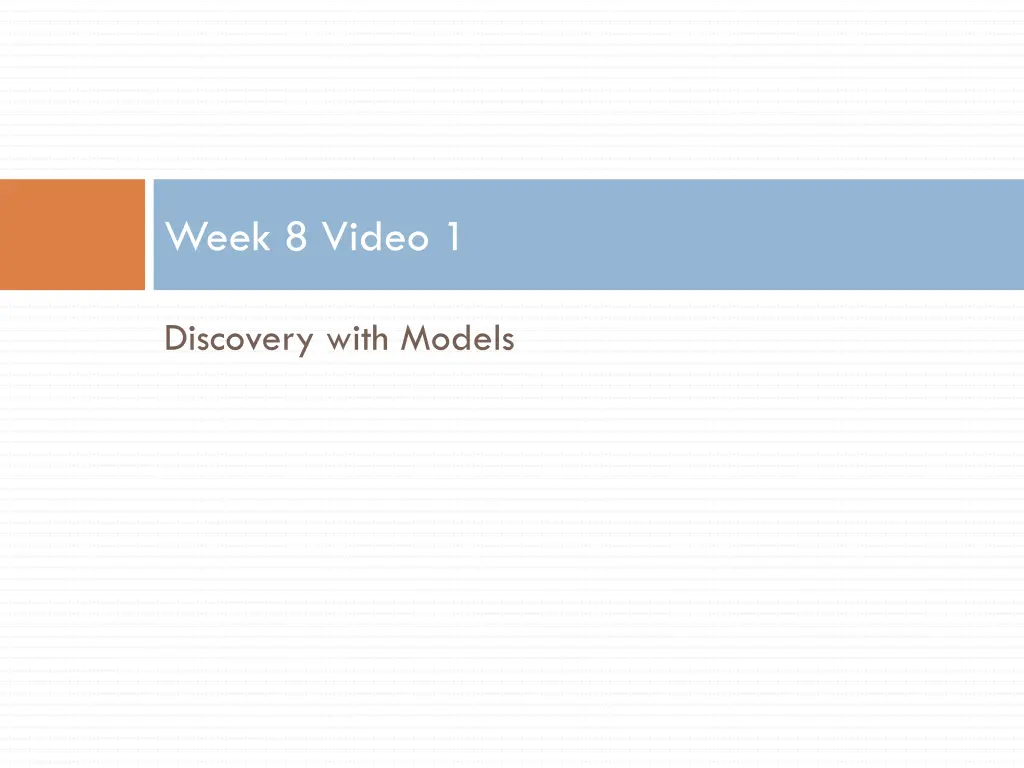
Unveiling the Simplicity of Discovery with Models
Delve into the world of discovery with models, where simplicity reigns despite initial trickiness. Explore how models are developed, used in prediction and relationship mining, and even stacked on top of each other for enhanced insights. Witness the guest lecture by Maria Baker as she unravels the fundamentals. Models predicting outcomes variegated from online course completion to affective states are presented, showcasing the versatility and power of model-based analysis in various domains.
Download Presentation

Please find below an Image/Link to download the presentation.
The content on the website is provided AS IS for your information and personal use only. It may not be sold, licensed, or shared on other websites without obtaining consent from the author. If you encounter any issues during the download, it is possible that the publisher has removed the file from their server.
You are allowed to download the files provided on this website for personal or commercial use, subject to the condition that they are used lawfully. All files are the property of their respective owners.
The content on the website is provided AS IS for your information and personal use only. It may not be sold, licensed, or shared on other websites without obtaining consent from the author.
E N D
Presentation Transcript
Week 8 Video 1 Discovery with Models
Discovery with Models: Seems Tricky
Discovery with Models: Seems Tricky But, in fact, discovery with models is so simple that a 6-year old could explain it
Discovery with Models: Seems Tricky But, in fact, discovery with models is so simple that a 6-year old could explain it And now, here to do so, is today s guest lecturer, Maria Baker
Discovery with Models: The Big Idea A model of a phenomenon is developed Via Prediction Clustering Knowledge Engineering This model is then used as a component in another analysis
Discovery with models can be used in Prediction The created model s predictions are used as predictor variables in predicting a new variable E.g. Classification, Regression
Can be used in Relationship Mining The relationships between the created model s predictions and additional variables are studied This can enable a researcher to study the relationship between a complex latent construct and a wide variety of observable constructs E.g. Correlation mining, Association Rule Mining
Models on top of Models Another area of Discovery with Models is composing models out of other models Examples: Models of Gaming the System and Help-Seeking use Knowledge Tracing models as components (Baker et al., 2004, 2008a, 2008b; Aleven et al., 2004, 2006; Paquette et al., 2014) A model of Wheel-Spinning uses a Knowledge Tracing model as a component (Matsuda et al., 2016 Models predicting online course completion and grades use linguistic models on discussion forum text (Crossley et al., 2015, 2016; Dascalu et al., 2021) Models predicting long-term outcomes use models of Affect, Off-Task, Gaming the System, Carelessness, Knowledge as components (Pardos et al., 2013; San Pedro et al., 2013; Yeung & Yeung, 2019; Almeda & Baker, 2020)
Models on top of Models When I talk about this, people often worry about building a model on top of imperfect models Will the error pile up ?
Models on top of Models May not be as big a risk as people worry about If the final model successfully predicts the final construct, do we care if the model it uses internally is imperfect? Systematic error at each step is taken into account at the next step! That said, there are some validity issues that should be taken into account more on that in a minute
Advantages of DWM Possible to Analyze Phenomena at Scale Even for constructs that are latent expensive to label by hand
Advantages of DWM Possible to Analyze Phenomena at Scale At scales that are infeasible even for constructs that are quick & easy to label by hand Scales easily from hundreds to millions of students Entire years, over a decade (Yeung & Yeung, 2019; Almeda & Baker, 2020), (eventually) entire lifetimes Predicting Nobel Prize winners from kindergarten drawings?
Advantages of DWM Supports inspecting and reconsidering coding later Leaves clear data trails Can substitute imperfect model with a better model later and re-run Promotes replicability, discussion, debate, and scientific progress
Disadvantages of DWM Easy to Do Wrong!
Discovery with Models: Here There Be Monsters Rar.
Discovery with Models: Here There Be Monsters It s really easy to do something badly wrong, for some types of Discovery with Models analyses No warnings when you do
Think Validity Validity is always important for model creation Doubly-important for discovery with models Discovery with Models almost always involves applying model to new data How confident are you that your model will apply to the new data?
Challenges to Valid Application Many challenges to valid application of a model within a discovery with models analysis
Challenges to Valid Application Is model valid for population? Is model valid for all tutor lessons? (or other differences) Is model valid for setting of use? (classroom versus homework?) Is the model valid in the first place? (especially important for knowledge engineered models)
Increasingly Important Baker & Yacef (2009) argued that Discovery with Models is a key emerging area of EDM I think it s fair to say this area has not emerged the way we expected back then
Increasingly Important Maybe it s just easier to start with raw features Maybe people aren t good at sharing their models Maybe it s more common to study a theme across several data sets than to extensively work within one system Maybe it s hard to do right Discovery with Models does seem beneficial when it s used Hard to know
Next lecture Discovery with Models: Case Study
